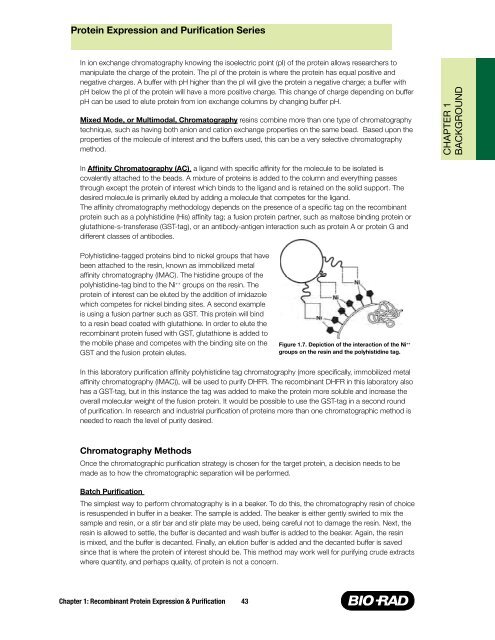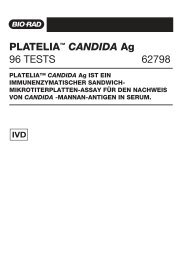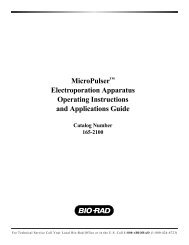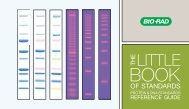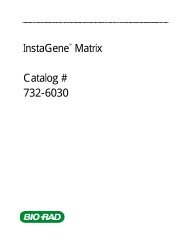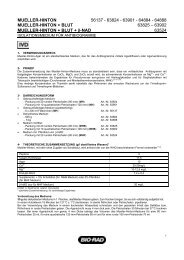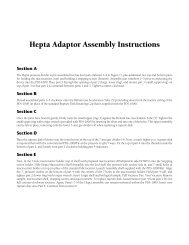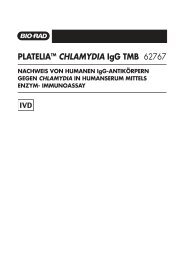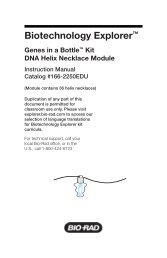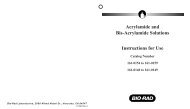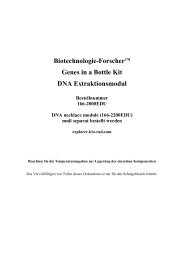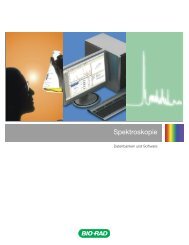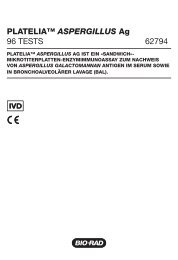Protein Expression and Purification Series - Bio-Rad
Protein Expression and Purification Series - Bio-Rad
Protein Expression and Purification Series - Bio-Rad
You also want an ePaper? Increase the reach of your titles
YUMPU automatically turns print PDFs into web optimized ePapers that Google loves.
<strong>Protein</strong> <strong>Expression</strong> <strong>and</strong> <strong>Purification</strong> <strong>Series</strong><br />
In ion exchange chromatography knowing the isoelectric point (pI) of the protein allows researchers to<br />
manipulate the charge of the protein. The pI of the protein is where the protein has equal positive <strong>and</strong><br />
negative charges. A buffer with pH higher than the pI will give the protein a negative charge; a buffer with<br />
pH below the pI of the protein will have a more positive charge. This change of charge depending on buffer<br />
pH can be used to elute protein from ion exchange columns by changing buffer pH.<br />
Mixed Mode, or Multimodal, Chromatography resins combine more than one type of chromatography<br />
technique, such as having both anion <strong>and</strong> cation exchange properties on the same bead. Based upon the<br />
properties of the molecule of interest <strong>and</strong> the buffers used, this can be a very selective chromatography<br />
method.<br />
In Affinity Chromatography (AC), a lig<strong>and</strong> with specific affinity for the molecule to be isolated is<br />
covalently attached to the beads. A mixture of proteins is added to the column <strong>and</strong> everything passes<br />
through except the protein of interest which binds to the lig<strong>and</strong> <strong>and</strong> is retained on the solid support. The<br />
desired molecule is primarily eluted by adding a molecule that competes for the lig<strong>and</strong>.<br />
The affinity chromatography methodology depends on the presence of a specific tag on the recombinant<br />
protein such as a polyhistidine (His) affinity tag; a fusion protein partner, such as maltose binding protein or<br />
glutathione-s-transferase (GST-tag), or an antibody-antigen interaction such as protein A or protein G <strong>and</strong><br />
different classes of antibodies.<br />
Polyhistidine-tagged proteins bind to nickel groups that have<br />
been attached to the resin, known as immobilized metal<br />
affinity chromatography (IMAC). The histidine groups of the<br />
polyhistidine-tag bind to the Ni ++ groups on the resin. The<br />
protein of interest can be eluted by the addition of imidazole<br />
which competes for nickel binding sites. A second example<br />
is using a fusion partner such as GST. This protein will bind<br />
to a resin bead coated with glutathione. In order to elute the<br />
recombinant protein fused with GST, glutathione is added to<br />
the mobile phase <strong>and</strong> competes with the binding site on the<br />
GST <strong>and</strong> the fusion protein elutes.<br />
In this laboratory purification affinity polyhistidine tag chromatography (more specifically, immobilized metal<br />
affinity chromatography (IMAC)), will be used to purify DHFR. The recombinant DHFR in this laboratory also<br />
has a GST-tag, but in this instance the tag was added to make the protein more soluble <strong>and</strong> increase the<br />
overall molecular weight of the fusion protein. It would be possible to use the GST-tag in a second round<br />
of purification. In research <strong>and</strong> industrial purification of proteins more than one chromatographic method is<br />
needed to reach the level of purity desired.<br />
Chromatography Methods<br />
Once the chromatographic purification strategy is chosen for the target protein, a decision needs to be<br />
made as to how the chromatographic separation will be performed.<br />
Batch <strong>Purification</strong><br />
The simplest way to perform chromatography is in a beaker. To do this, the chromatography resin of choice<br />
is resuspended in buffer in a beaker. The sample is added. The beaker is either gently swirled to mix the<br />
sample <strong>and</strong> resin, or a stir bar <strong>and</strong> stir plate may be used, being careful not to damage the resin. Next, the<br />
resin is allowed to settle, the buffer is decanted <strong>and</strong> wash buffer is added to the beaker. Again, the resin<br />
is mixed, <strong>and</strong> the buffer is decanted. Finally, an elution buffer is added <strong>and</strong> the decanted buffer is saved<br />
since that is where the protein of interest should be. This method may work well for purifying crude extracts<br />
where quantity, <strong>and</strong> perhaps quality, of protein is not a concern.<br />
Chapter 1: Recombinant <strong>Protein</strong> <strong>Expression</strong> & <strong>Purification</strong><br />
43<br />
Figure 1.7. Depiction of the interaction of the Ni ++<br />
groups on the resin <strong>and</strong> the polyhistidine tag.<br />
CHAPTER 1<br />
BACKGROUND


